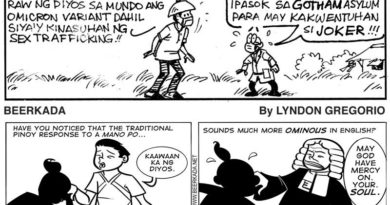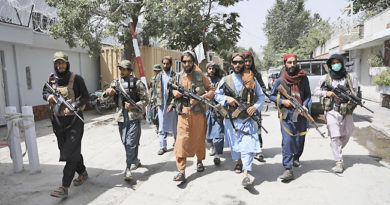L.A. STORIES -Essential California: 11.8.2021- L.A. sheriff’s deputies use minor stops to search bicyclists, with Latinos hit hardest
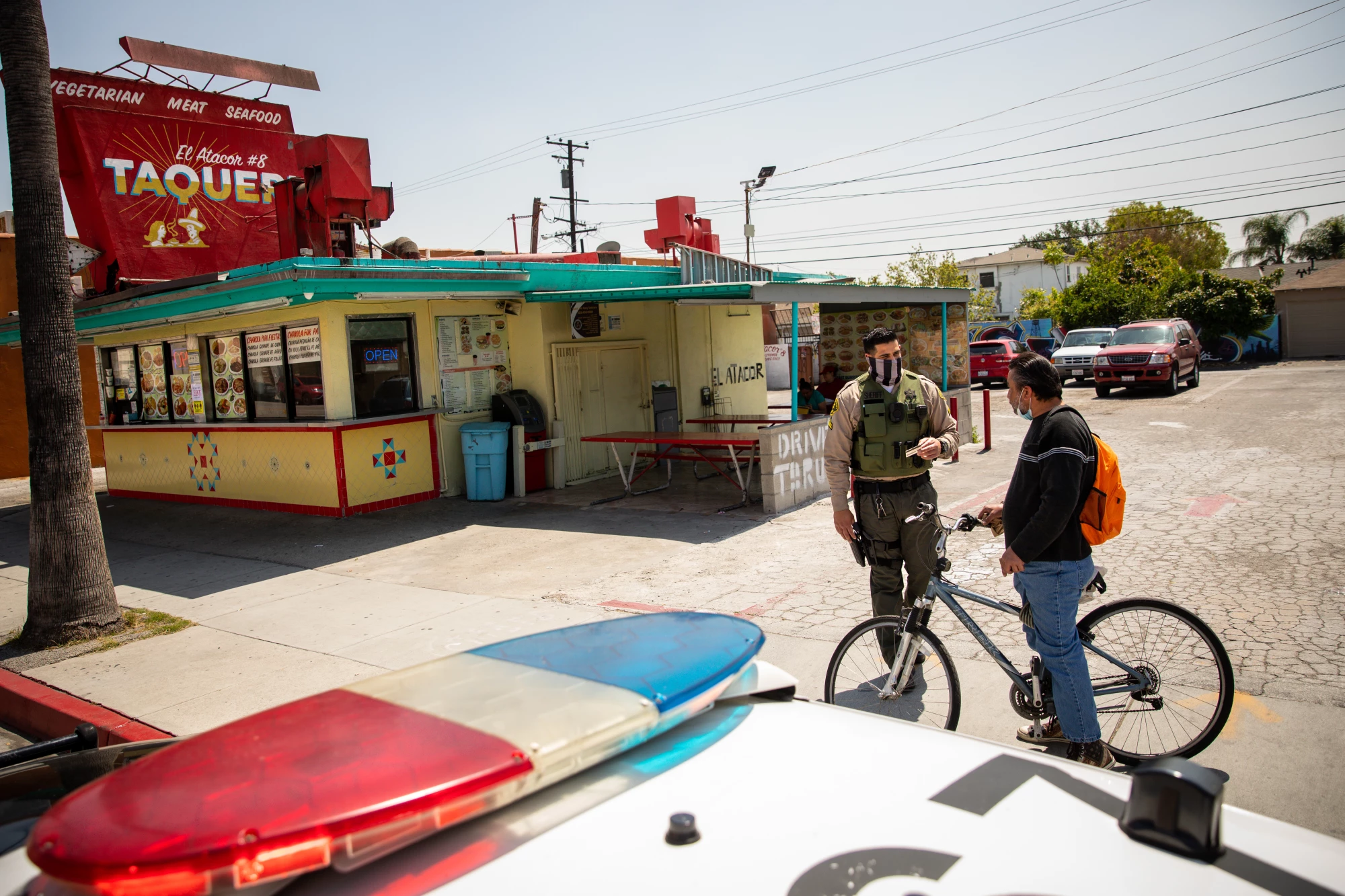 L.A. County Sheriff’s Deputy Manan Butt warns Sirilo Villalpando that he’s not allowed to ride his bike on the sidewalk in East L.A. (Jay L. Clendenin/Los Angeles Times)
L.A. County Sheriff’s Deputy Manan Butt warns Sirilo Villalpando that he’s not allowed to ride his bike on the sidewalk in East L.A. (Jay L. Clendenin/Los Angeles Times)
Thousands of times a year, Los Angeles County sheriff’s deputies pull over bicyclists for minor violations such as riding on the sidewalk or not using lights at night — infractions that can be handled with a warning or a ticket.
But deputies routinely escalate the stops into more intrusive encounters and disproportionately pull over Latino riders.
A Los Angeles Times investigation found deputies search 85% of bike riders they stop even though they often have no reason to suspect they’ll find something illegal. Most bicyclists were held in the backseat of patrol cars while deputies rummaged through their belongings or checked for arrest warrants.
The Times’ analysis of more than 44,000 bike stops logged by the Sheriff’s Department since 2017 found that 7 of every 10 stops involve Latino cyclists, and bike riders in poorer communities with large nonwhite populations are stopped and searched far more often than those in more affluent, whiter parts of the county.
For all the stops and searches, deputies rarely catch criminals. During searches, they find illegal items just 8% of the time, The Times’ analysis shows. Weapons were seized just 164 times — less than half a percent of all searches.
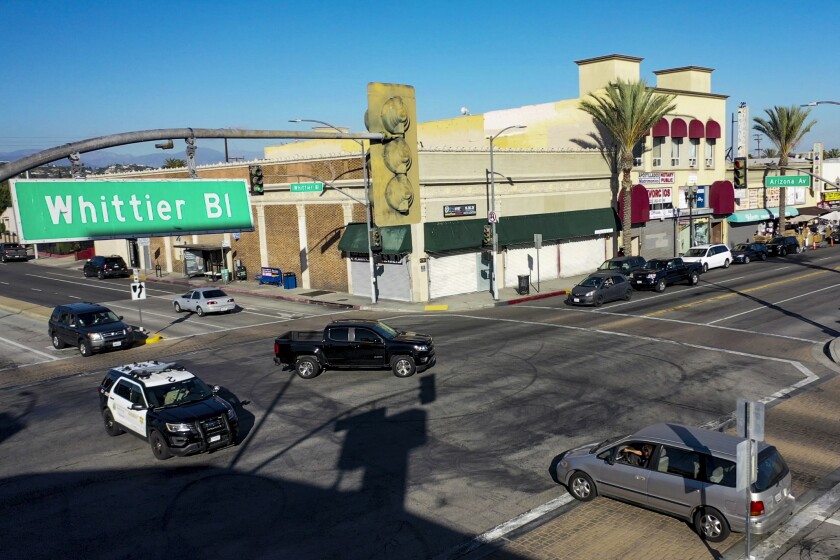
The Times interviewed cyclists in some of the communities most frequently targeted by the Sheriff’s Department, including 40 who had been stopped at least once and in some cases multiple times. Many came away angry and humiliated, describing the stops as small but nonetheless hurtful injustices of having their freedom momentarily stripped so a deputy could go on a fishing expedition.
“You feel powerless,” said Ubaldo Delacruz, a Boyle Heights resident who has been stopped several times in East L.A.
“People, they assume, they’re on bicycles, they’re … some sort of criminal,” he said.
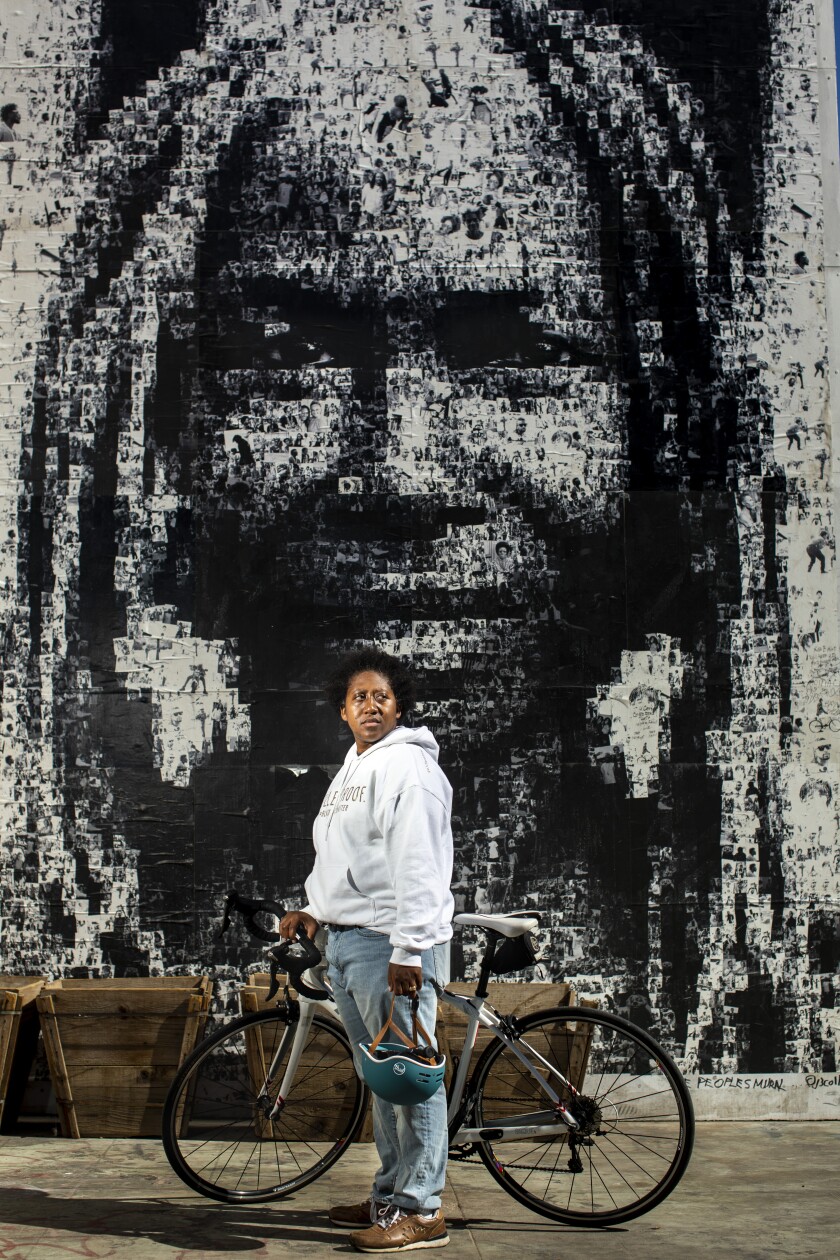
Sheriff’s officials defended the use of bike stops as a necessary and legitimate tool to fight crime, arguing that criminals use bikes to evade detection. The low rates of success deputies have finding drugs or other contraband while searching bicyclists “do not raise serious questions,” a department spokeswoman told The Times.
The inequities in how the Sheriff’s Department uses bike stops come to light amid a broader national debate over whether police should no longer be permitted to pull over motorists — and bike riders — for small infractions.
“It’s just another version of stop and frisk,” said Tamika Butler, former head of the Los Angeles County Bicycle Coalition, comparing the sheriff’s enforcement to the New York City Police Department’s practice of patting down Latinos and Black people. The NYPD tactic, now defunct, was found to have violated people’s civil rights. “It’s just another way to profile, to stop, to harass.”
Los Angeles County is built largely for automobiles. Bicyclists are second-class travelers, often left to vie for space alongside cars on congested, poorly maintained streets.
They ride for a host of reasons, but many have no choice. They cannot afford a car, as well as the gas, registration fees and other expenses that come with driving in a sprawling metropolis.
And they ride despite risks. Hit-and-run collisions are an intractable problem in the county, and efforts to build dedicated bike lanes have been uneven.
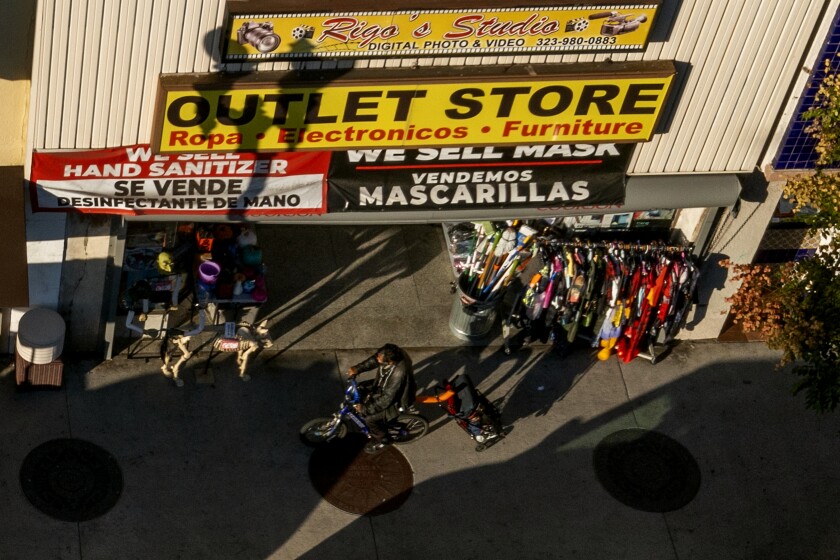
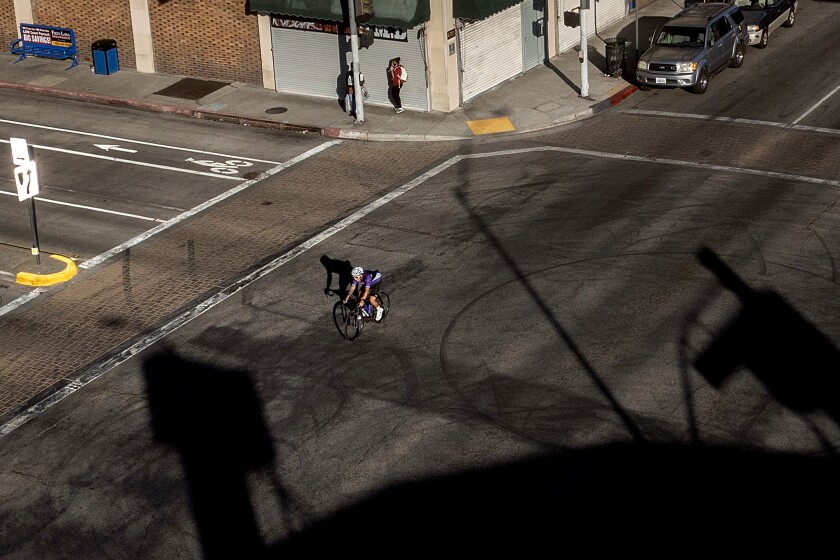
Top: An aerial view of a bicyclist riding down Whittier Boulevard at sunset in East Los Angeles. Bottom: A bicyclist crosses the intersection of Whittier Boulevard and Arizona Avenue in East L.A. (Allen J. Schaben/Los Angeles Times)
Times reporters fanned out across the streets of various neighborhoods in L.A. County and interviewed people they encountered riding their bikes, as well as nearly a dozen biking advocates.
Many riders said they had been pulled over riding to work or running errands. A Latino rider in East L.A. was headed home with two bags of clean clothes after a visit to a laundromat. A Black man felt that the color of his skin led to him being stopped in West Hollywood while he was making food deliveries late one night. Many said deputies were suspicious of them simply for riding a bike.
“They would even ask me, ‘Why don’t you [drive]? Is that by choice?’” said Gabriel Ledesma, 48, a Latino cook from East L.A. who said deputies have stopped and searched him several times while he was biking in his neighborhood. “I never saved enough money when I was growing up and I never learned how to drive, so that’s why I’m on a bike.”
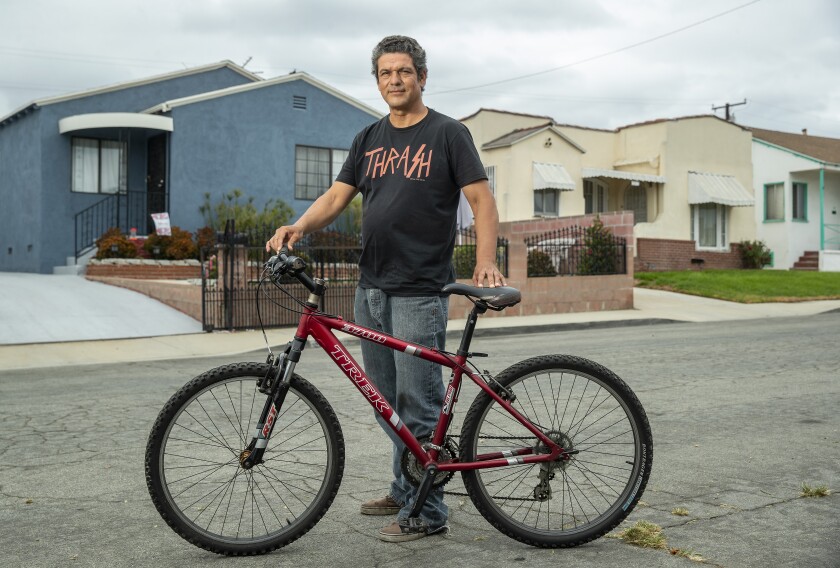
Many bicyclists said they were asked if they were on probation or parole and if they had drugs or weapons. The Sheriff’s Department data mirror their experiences. Deputies asked 93% of riders about their probation or parole status. And in 71% of stops, cyclists were held in the backseat of a patrol car while deputies searched their backpacks or checked to see if they had outstanding arrest warrants.
Some cyclists shrugged off the encounters as an inconvenience that comes with living in high-crime neighborhoods. Others felt deeply harassed, targeted because they fit the vague description of a crime suspect deputies claimed to be searching for, usually because they were the same race.
Being stopped was even more disruptive for some riders interviewed. One white bicyclist in Norwalk said he lost his job because he was two hours late to work after he was held in the backseat of a patrol car while deputies searched his belongings and questioned him about who in the neighborhood was dealing drugs and carrying guns. A Latino rider in East L.A. said deputies took him to jail after they found a pipe in a bag of recyclables he planned to redeem for cash. A Black rider said a deputy confronted him at gunpoint and ordered him to stop while he was riding home from Lueders Park in Compton and doesn’t understand why.
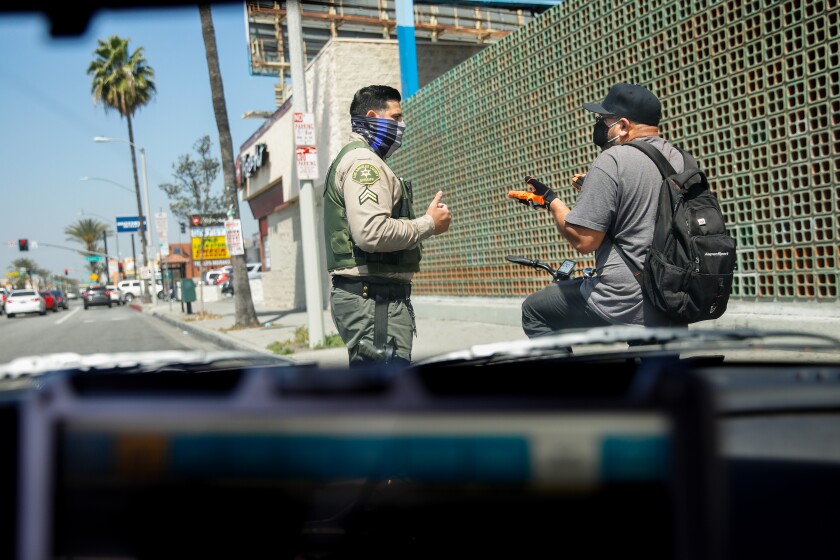
Delacruz was riding on the sidewalk on Whittier Boulevard in East L.A. one Friday in April when Sheriff’s Deputy Manan Butt pulled up next to him and called out for him to stop. Times reporters observed from inside the patrol car.
The deputy told Delacruz he was not allowed to ride on the sidewalk and asked for identification.
He didn’t have his license with him and, at first, he resisted telling Butt his name. Since he had agreed to ride on the street, he said later, he didn’t think he should have to answer any more questions.
Delacruz told Butt, “You want to know if I have warrants.” He told the deputy he didn’t.
But, fearing he was making matters worse for himself by refusing, Delacruz relented and gave his name.
Butt ran Delacruz’s name and saw he was telling the truth. He let him off with a warning.
Butt told The Times afterward that he became more suspicious of Delacruz when he refused to identify himself.
The encounter, at least his third in four years, left Delacruz feeling angry.
“The [deputy] told me, ‘You are not supposed to be riding on the sidewalk.’ I said, ‘OK, fine, let me get on the street, that’ll be the end of it,’” Delacruz told The Times. “But, no, he has to ask if I have warrants, if I’ve been on parole or anything like that.”
Records show the previous times he was stopped, deputies had searched Delacruz’s pockets and belongings, finding nothing illegal. He said he was given a ticket in one of the stops for riding without a bike light. Delacruz bought lights after that.
But he and other riders say it’s often safer to ride on the sidewalk, especially on streets clogged with traffic. There are no bike lanes on Whittier Boulevard where Delacruz was stopped, and just 1% of streets in all of East Los Angeles have them.
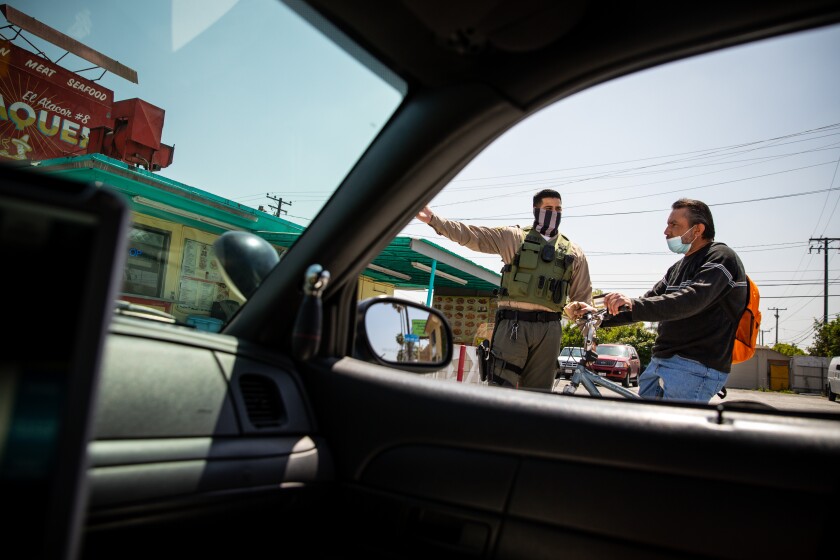
“I’d rather go slow on the sidewalk than risking my life,” said Sirilo Villalpando, another Latino rider stopped in East L.A. in April for riding on the sidewalk. He gestured to the street, where a crack gaped along uneven pavement on Whittier Boulevard. “If I wobble right there,” he said, then made the sound of a crash.
Surveys conducted by the nonprofit Los Angeles County Bicycle Coalition found riders are twice as likely to ride on the sidewalk on streets with no bike lanes than those with them.
About 8% of all bike stops by the Sheriff’s Department are for sidewalk violations. But in neighborhoods with few bike lanes, a far higher percentage of stops are for riding on the sidewalk, The Times’ analysis shows. Many of those neighborhoods are home to predominantly Black and Latino, lower-income residents.
For example, nearly a quarter of bike stops in East L.A. were for sidewalk violations, one of the highest rates in the sheriff’s jurisdiction. And in Lynwood, where there are no bike lanes at all, they account for 16% of stops.
By contrast, West Hollywood, which is mostly white, has a much higher percentage of streets with bike lanes. The city’s code allows bikers to ride on the sidewalk in areas with no bike lanes, and less than 1% of bike stops there were initiated because of sidewalk violations.
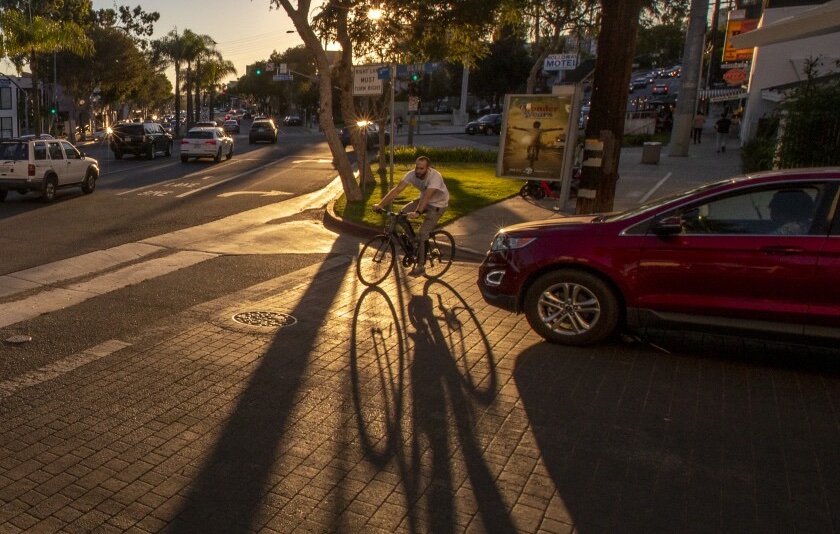
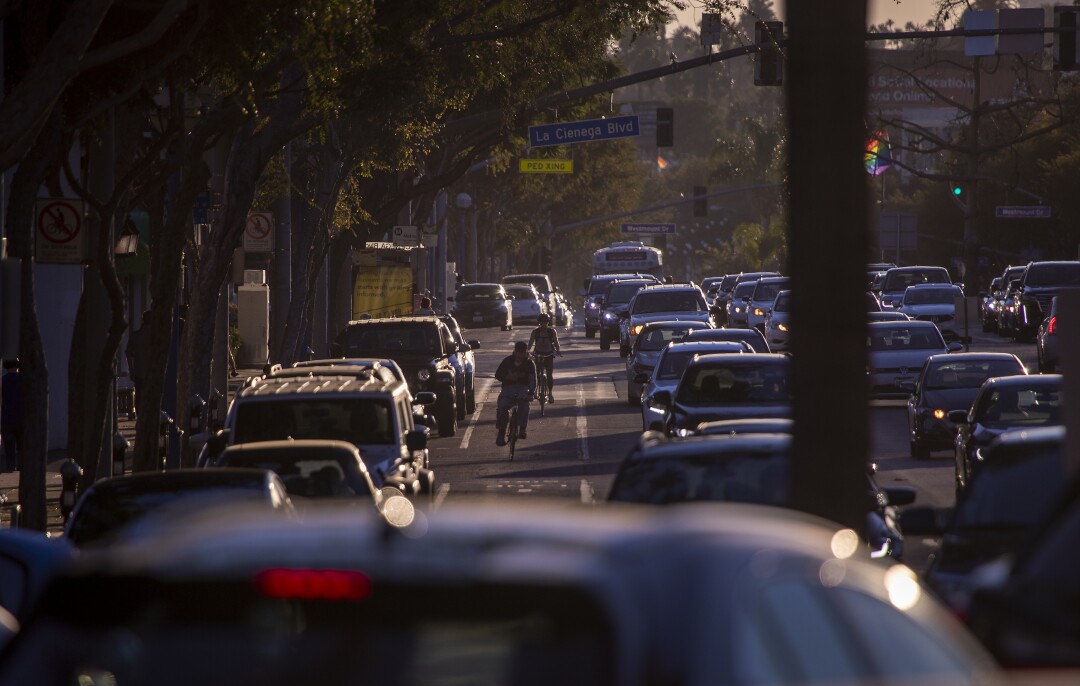
West Hollywood lets bicyclists ride on the sidewalk in areas with no bike lanes. The city also has a higher percentage of bike lanes than other parts of the sheriff’s patrol area. (Allen J. Schaben / Los Angeles Times)
On his patrol shift one afternoon in April, Deputy Butt spotted a man glide across lanes and into an alley on a light blue bike with rusty wheels. He called out for the man to stop, pulling him over near a dumpster tagged with graffiti.
The man was on probation, which meant the deputy could legally search him, and he told Butt he had needles in his pocket.
Butt slipped on black gloves, held the man’s hands behind his back and emptied his pockets onto his patrol car: two needles, one of which was open, a charging cable, two lighters and a piece of metal the shape of a bottle cap.
Butt ticketed the man for unsafe biking and cited him on an old warrant, giving him a new date to appear in court.
For his safety, Butt said he asks everyone he stops if they have weapons. He said he considers several variables that may lead him to conduct a search — a person’s level of cooperation, a bulge under their shirt, the time of day or night and the number of people being stopped.
“We don’t just stop people and search them out for no reason,” Butt said.
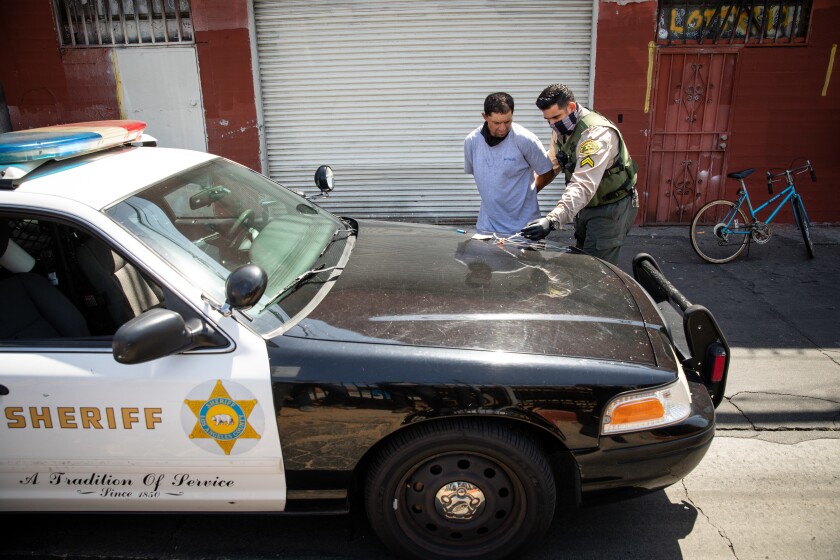
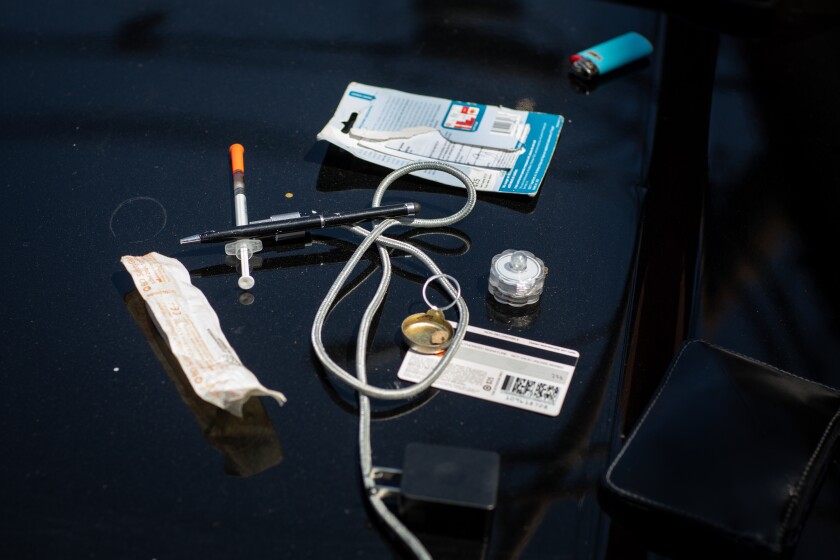
Top: Los Angeles County Sheriff’s Deputy Manan Butt searches a man who was on probation. Bottom: Butt found two needles and other items in the man’s pockets. (Jay L. Clendenin / Los Angeles Times)
The Times shared its findings with sheriff’s officials and repeatedly sought comment from Sheriff Alex Villanueva, who declined to respond. An interview arranged with the assistant sheriff who oversees the agency’s patrol operations was canceled by a sheriff’s spokesman without explanation.
In a written response to questions The Times submitted, Lt. Lorena Rodriguez, a department spokeswoman, said riding a bike allows criminals “to traverse a neighborhood unnoticed, faster and safer than on foot, and additionally makes it easier to avoid police contact. We are not conducting traffic stops of persons obviously engaged in the use of a bicycle for exercise or amusement.”
“We don’t just stop people and search them out for no reason.”
Sheriff’s officials would not address the disparities The Times uncovered in the bike stop data and declined to answer questions about why Latino cyclists are stopped at high rates.
They did not provide specific examples of how searches of riders stopped for minor biking violations improve public safety.
A missing reflector and other small equipment infractions, for example, were the basis for at least 44% of the Sheriff’s Department’s bike stops analyzed by The Times. More than 8 of every 10 of those stops led to searches.
Each time a deputy stops someone riding a bike, they log details about the encounter in a department database. The Times obtained a copy of the database for stops from the start of 2017 through the end of July this year under the state’s open records law.
The data show that sheriff’s deputies discovered drugs in less than 6% of searches, The Times found. Overall, 21% of bicyclists were either arrested or issued a citation to appear in court for an alleged crime. The Times reviewed 100 of the arrests and found most people were arrested either for low-level drug offenses or because a warrant had been issued after they failed to appear in court for a previous drug case.
“You’re not improving safety,” said Ojmarrh Mitchell, criminology professor at Arizona State University who co-wrote a 2016 U.S. Department of Justice report that examined bike stops by the Tampa Police Department. “You’ve conducted all these intrusive stops and you’re alienating a large portion of the community, largely communities of color. It’s low benefit, high consequences.”
Since 2005, 16 bike stops for minor infractions have led to a police shooting in L.A. County, according to a recent Times’ analysis of records.
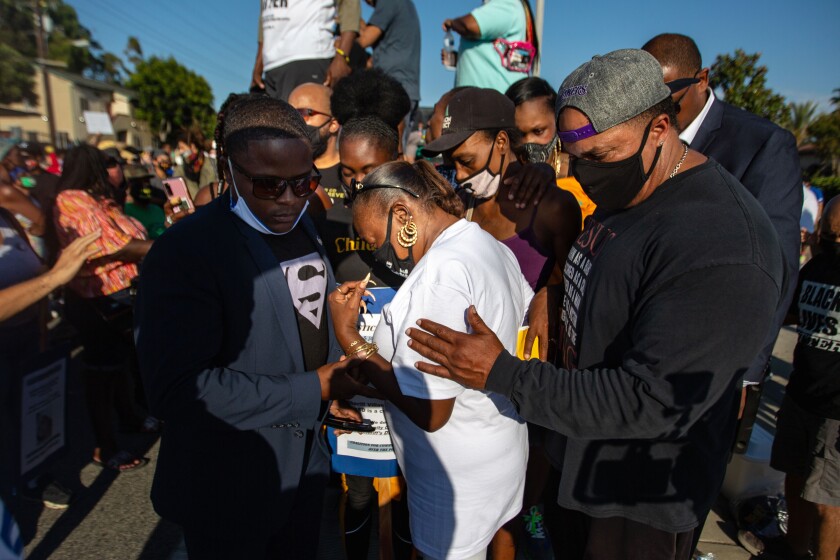
Last year, deputies shot and killed Dijon Kizzee, a Black man they attempted to pull over in South L.A. for riding a bike on the wrong side of the street. The shooting, which the county district attorney is still reviewing, prompted weeks of protests.
The Sheriff’s Department has come under fire before for how deputies stop and search people. The agency’s Domestic Highway Enforcement Team, which pulled over motorists on the 5 Freeway in search of drugs, was suspended in 2018 after a Times investigation found Latinos were disproportionately targeted. The county’s inspector general later found the team “had a constitutionally troubling impact on Latino drivers.”
And a federal investigation several years ago found that sheriff’s deputies systematically harassed Black and Latino residents in the Antelope Valley, leading to a consent decree.
Jonathan García, a longtime resident of East L.A., said he was crouched over fixing the chain on his bike one night when a deputy approached.
The deputy said that he was obstructing the sidewalk. García looked both ways. The sidewalk was nearly empty.
The deputy patted him down, then held García in the back of his squad car while he checked García’s name for warrants. García, who is Latino, said the deputy then emptied the contents of his bag onto the hood of the car and looked through them for drugs or other illegal items.
“They’re trying to keep the community safe, because some people might be carrying drugs or dangerous weapons,” he said. “I just think they go a little overboard sometimes.”
Latinos account for slightly more than half of the residents and of bike riders in the sheriff’s patrol area.
But deputies pulled over Latino riders in 70% of bike stops, The Times found.
Experts caution that racial disparities in stop rates do not necessarily indicate bias. They could reflect differences in cycling behavior, neighborhood crime rates and other factors that can be difficult to quantify.
But the uneven impact on Latinos was clear in The Times’ comparison of stops in different neighborhoods.
Stops were conducted most frequently in places such as South El Monte, Commerce, Maywood and Willowbrook, where the populations are heavily Latino, and least frequently in wealthier, whiter areas.
For example, since 2017 more than 1,300 bike riders were stopped in South El Monte, a working-class city where more than 82% of residents are Latino. The city’s stop rate is 10 times higher than that of Malibu, a mostly white city where only 80 cyclists were stopped.
Deputies stopped fewer than 10 riders in upscale neighborhoods such as Agoura Hills and Westlake Village. In the affluent South Bay enclave of Rolling Hills Estates, deputies stopped just six riders. In East L.A., the historic heart of the county’s Latino population, deputies made 3,700 bike stops — the most of any of the neighborhoods patrolled by the Sheriff’s Department. And they searched 93% of riders they stopped there.

Cyclists in East L.A. more likely to be stopped, searched
Sheriff’s deputies searched 93% of riders they stopped in East L.A., a low-income, mostly Latino neighborhood. In West Hollywood, which is wealthier and whiter, 63% were searched.
West Hollywood
L.A. County Sheriff’s Department; Times analysis
“If these police practices were deployed in white areas, there would be massive resistance overnight: ‘Why are you stopping all of us? We’re not doing anything,’” said Mitchell, of Arizona State University.
Kevin Edelson, who is white, frequently rides his bike for exercise on the streets around his home in East L.A. He knows riding on the sidewalk is illegal but says he often does so anyway.
“I definitely know … the fact that I’m white I’m less likely to be stopped,” said Edelson, 28, a robotics engineer at NASA’s Jet Propulsion Laboratory. “I definitely keep that as a consideration of why I feel safer riding on the sidewalk, knowing that I have that ability and I am less likely to be stopped. It’s messed up.”
When Latinos are stopped, they are also more likely to be searched.




Latinos were subjected to searches in 88% of stops, compared with 80% of Black riders and 78% of white riders, The Times found.
But Latinos were the least likely to have contraband.
Deputies found illegal items, like drugs or weapons, in 7.1% of searches of Latino riders while 9.6% of searches of Black riders and 10.5% of white riders turned up contraband, The Times found.
Latinos were also held in the backseat of a patrol car in 77% of bike stops, compared with 58% of white riders and 55% of Black riders.
The findings make clear that Latinos are burdened far more heavily than others, said Mitchell, the criminology professor. “If they produced an offsetting benefit to the community by making it safer, I think you could make an argument to have these policies, but they don’t.”
He said the Sheriff’s Department’s overall bike stop search rate of 85% is “astounding.”
It’s more than double that of the Oakland Police Department, another large agency in California that specifically tracks bike stops. And it is three times as high as the overall search rate — including stops of vehicles and pedestrians in addition to riders — of a dozen of the state’s largest police agencies in 2019.
“This is just a dragnet,” said Jeffrey Fagan, a Columbia Law School professor who testified about the NYPD’s stop-and-frisk practice. “It’s really just a dragnet that really doesn’t pay very well.”
“These stops were made for searches.”
The Times found that the Sheriff’s Department’s aggressive approach doesn’t uncover more wrongdoing. Deputies conduct searches in bike stops four times as often as they do in all citizen encounters, including vehicle and pedestrian stops. However, they arrest, cite or ticket cyclists at about half the rate.
If the Sheriff’s Department were concerned with rider safety, it’d hand out bike lights or offer free classes on bike laws, civil rights and bike advocates said.
“These stops were made for searches,” Mitchell said. “You’ve committed this tiny infraction, and now the officer is asking to run their hands through your pockets or pat you down. It doesn’t make sense unless they were using the stop as a pretext.”
Sheriff’s Lt. Ann Devane said in March the high search rate of riders was unsurprising because bike stops are inherently dangerous and deputies conduct searches for their own safety.
“When you stop somebody on a bicycle, you’re in close proximity to them, so the deputy doesn’t have a lot of concealment or coverage,” Devane said. “You’re right there next to the person.”
However, deputies performed cursory pat-downs of a rider’s clothes for weapons in only 13% of stops, The Times’ analysis shows. Much more often — in 72% of stops — deputies conducted more invasive searches, going through riders’ pockets or fully inspecting their belongings.
Police officers can legally stop anyone who breaks a traffic law, no matter how minor, but there are limits on what they can do next. Officers can’t hold someone beyond the time it takes to handle the traffic violation and, to conduct a search, they need legal justification or to get permission.
L.A. County prosecutors in 2019 rejected one drug possession case The Times reviewed because deputies had not explained why, or for how long, they prolonged the detention of a bicyclist they stopped in Norwalk for riding on the sidewalk.
The Times found that in 51% of stops, deputies said they had received permission to conduct a search. That is a red flag for legal experts and advocates, who questioned whether it is possible for riders who are stopped to give meaningful consent to be searched.
“There’s an illusion of consent,” said Charles T. Brown, founder and president of the research firm Equitable Cities and adjunct professor at Rutgers University who studies transportation equity. “There isn’t anything in place that gives them the confidence to believe that they can say no.”
Police often ask for consent to search as a way to check for contraband when they don’t have the evidence to legally justify a search without a warrant. The U.S. Supreme Court has ruled that such searches are allowed unless the individual was coerced.
In some states, police are prohibited from asking for consent to search a car unless they have reasonable suspicion of a crime.
Deputy Russell Smith Goudy, who is a part of a crime suppression unit in the Sheriff’s Department’s Century station, said he typically asks bicyclists for consent to search them even in cases when he can do so without their permission.
“It never hurts to ask,” he said. “We can always ask.”
Alejandro Soto told The Times he was riding home from picking up tacos near Salazar Park in East L.A. one evening when a deputy and the rookie he was training stopped him.
Soto said he was pedaling on the street with bike lights, so he asked why he was being stopped. They told him it was a training exercise for the new deputy.
They asked if he had anything sharp that could poke or hurt them. He said no, but he gave them permission to search him. The rookie went through his pockets but turned up nothing.
The deputies let him go.










